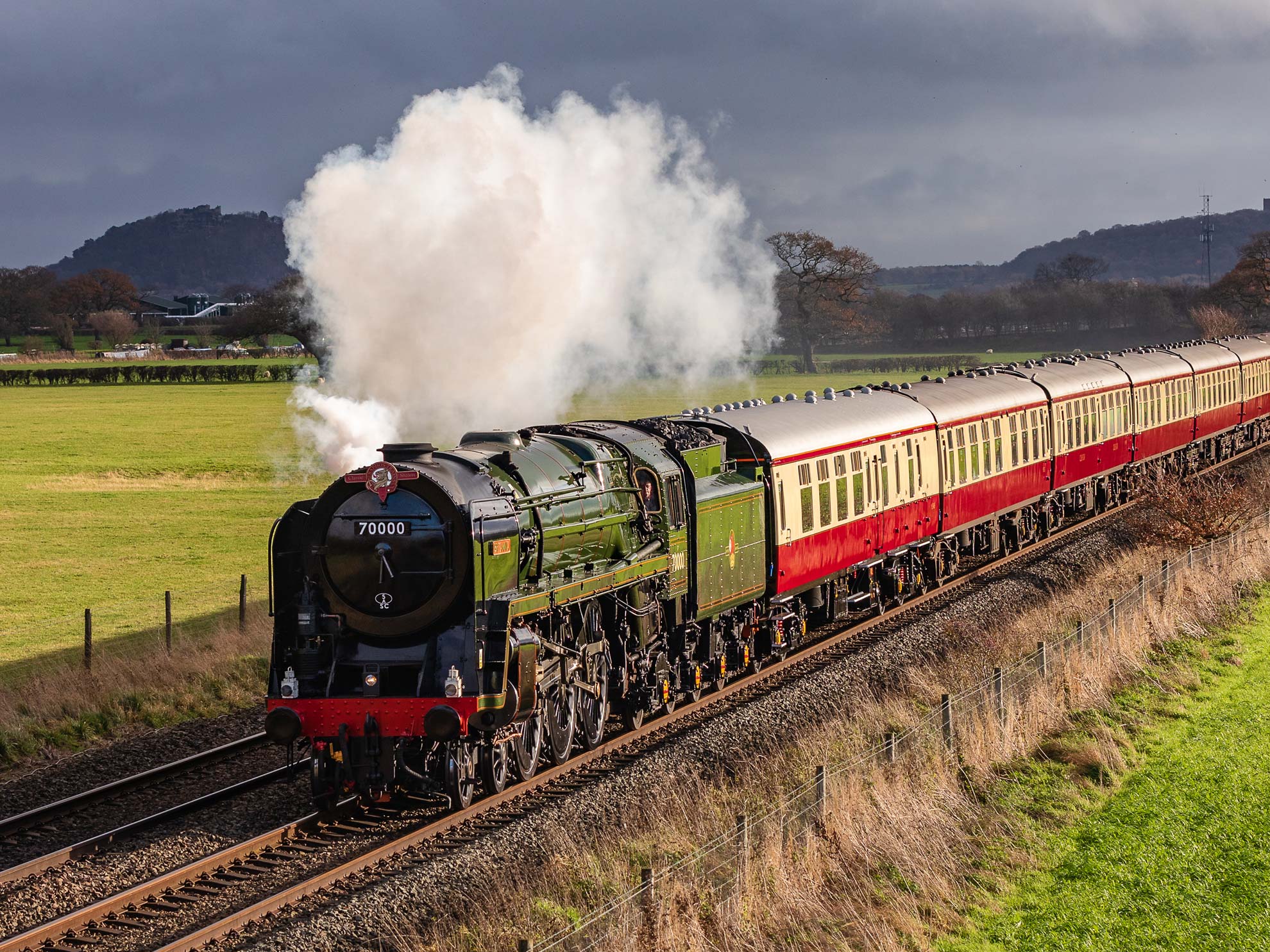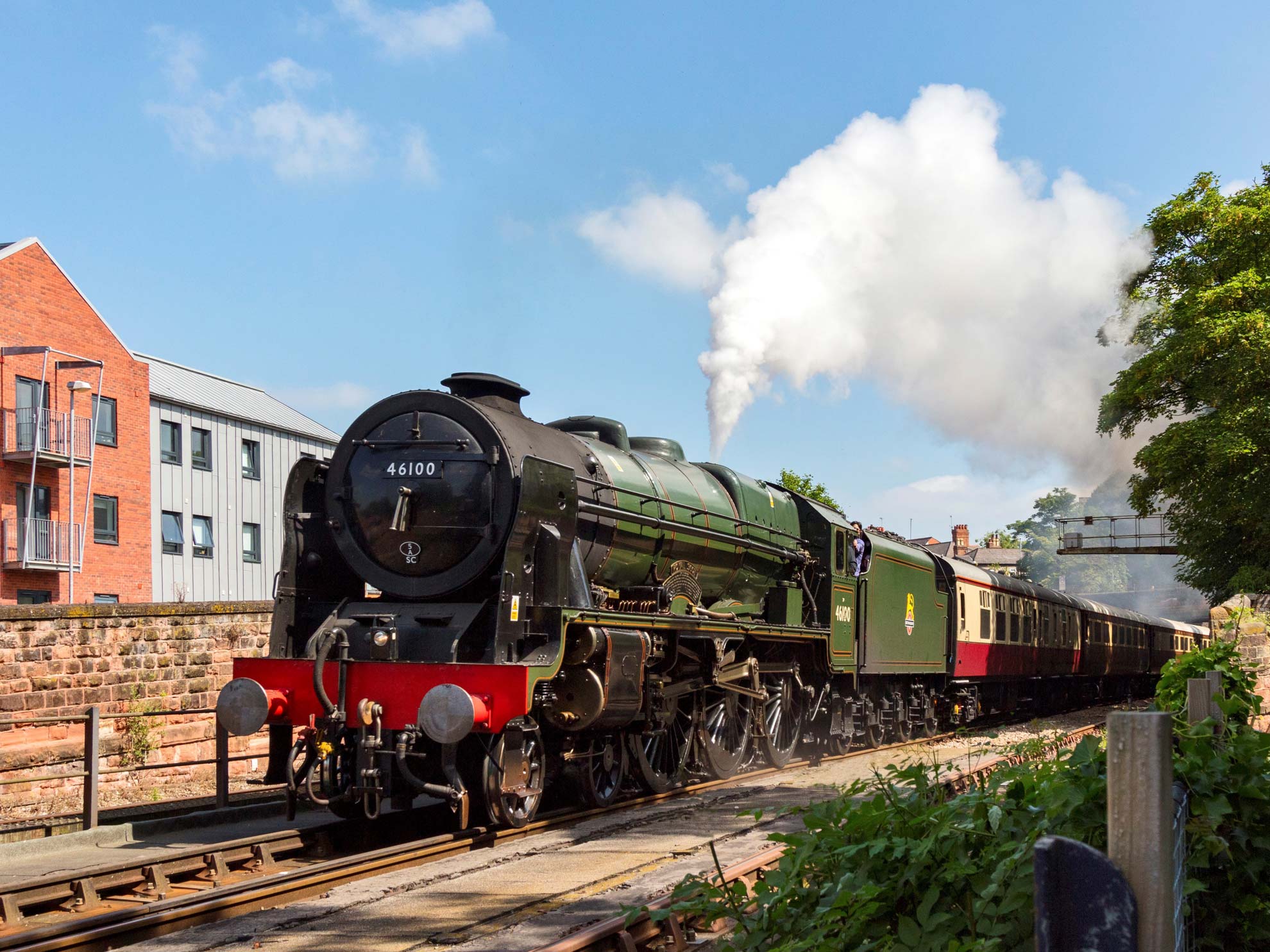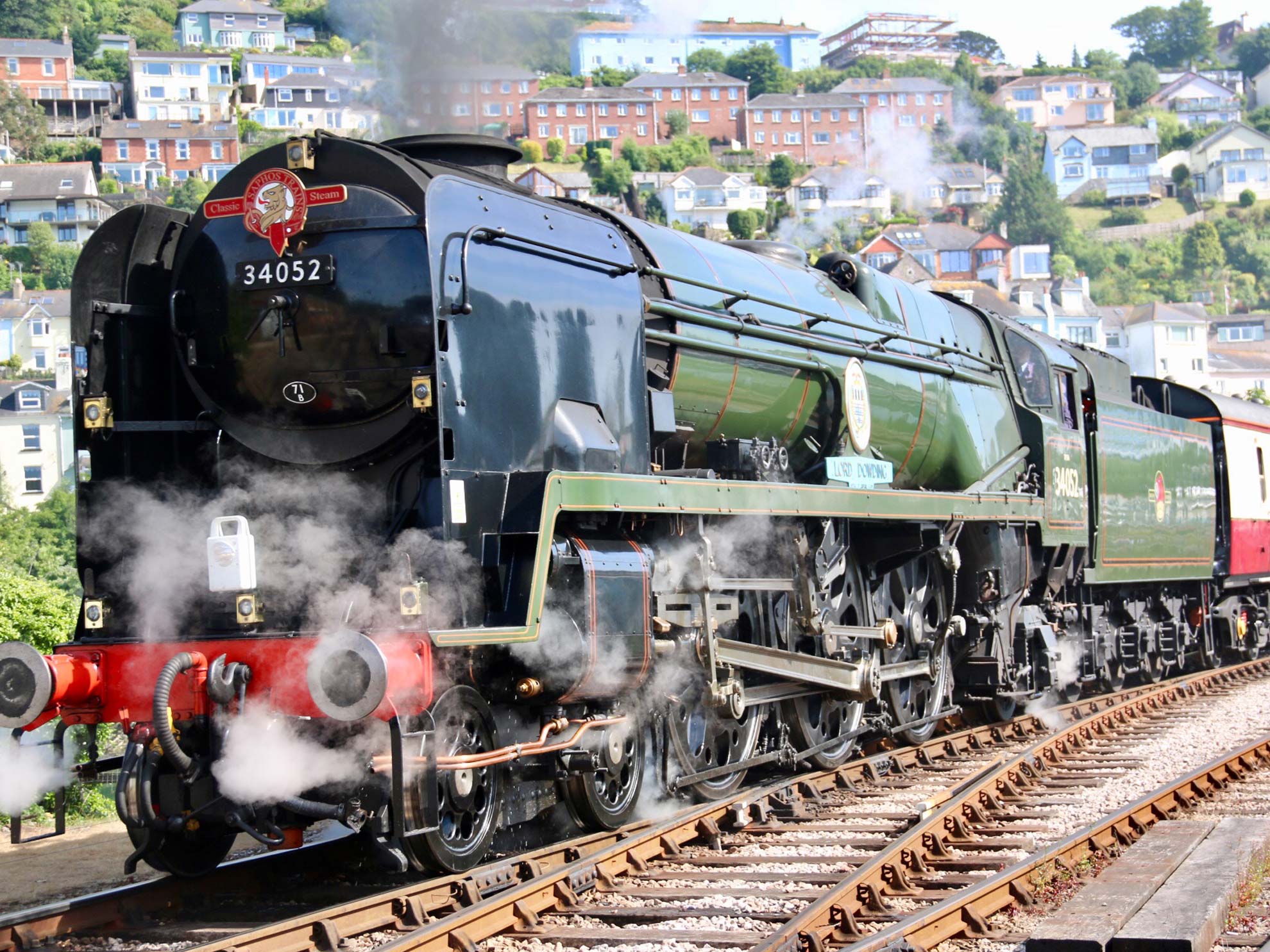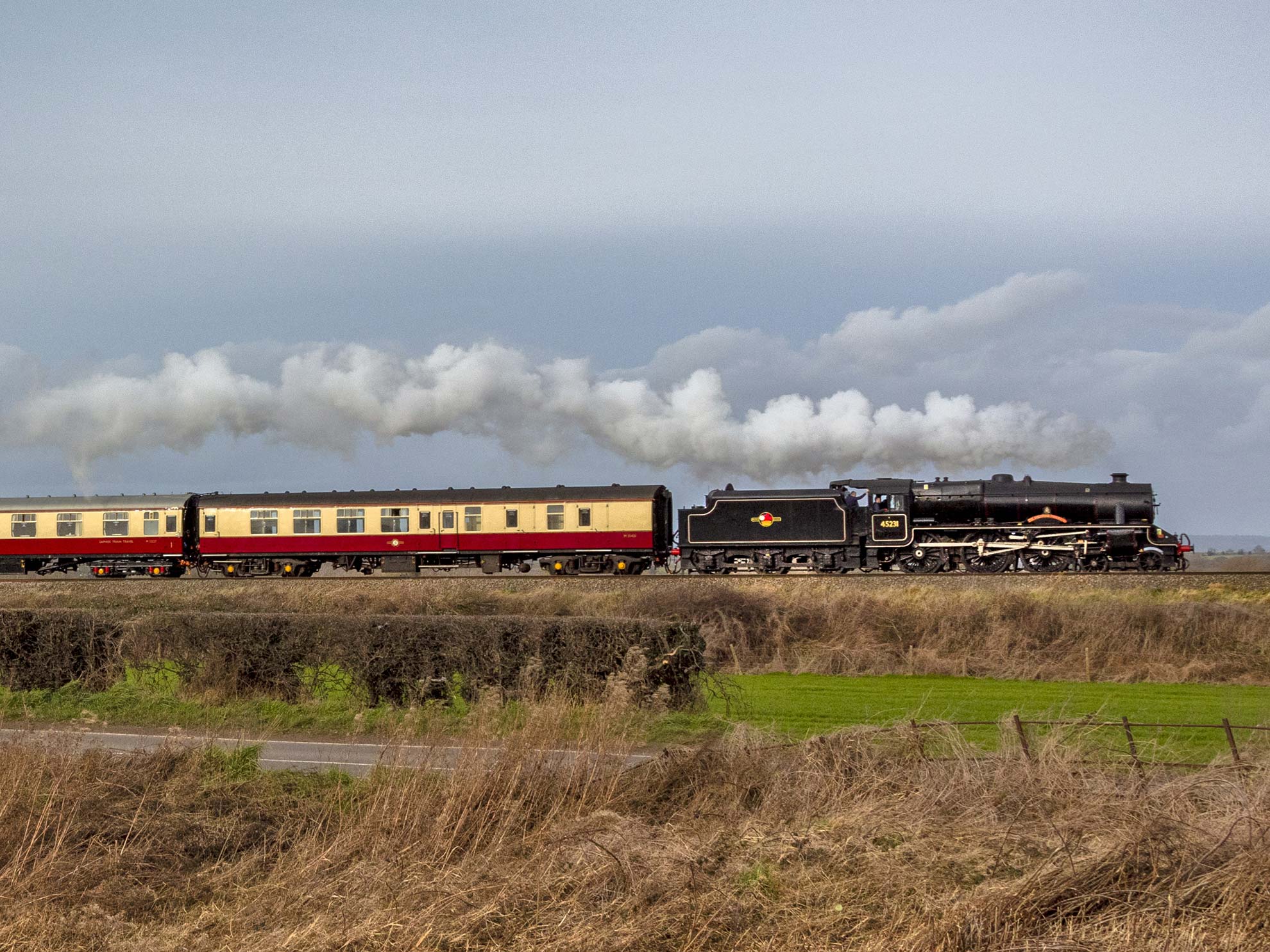BRITANNIA
BR Standard Class 7P 4-6-2 No. 70000
BR Standard Pacific 4-6-2 No. 70000 Britannia was built at Crewe Works, completed on January 2, 1951. She was the first British Railways standard locomotive to be built and the first of 55 locomotives of the Britannia class. The locomotive was named at a ceremony at Marylebone station by the then Minister for Transport Alfred Barnes on 30 January 1951. After her construction at Crewe works, Britannia entered service in 1951. For the early part of her life she was based in London and East Anglia, working fast boat train services to the eastern docks. In her later years she was transferred north west, to work heavy trains on the West Coast Main Line from Manchester, Carlisle and Glasgow.
For many years, Britannia had her cab roof painted white. This was to commemorate her pulling the funeral train of King George VI from Norfolk to London following his death in February 1952 at Sandringham House, Norfolk. Britannia was withdrawn in May 1966, after 15 years of service. Initially destined for the National Railway Museum because of her cultural significance, she was stored. However, due to her prototype design and construction differences, the NRM chose standard sister 70013 Oliver Cromwell instead. Britannia was eventually bought by the Britannia Locomotive Company Limited.
After a series of moves, she was eventually returned to steam on the Severn Valley Railway, where she remained for a number of years in operational but non-mainline condition. With the society wishing to make more use of the locomotive, she was moved to the Nene Valley Railway in Peterborough, where she was also fitted with an air-brake compressor. Britannia made her return to the main line on 27 July 1991, successfully working enthusiast trips until 1997.
With an expired mainline boiler certificate, due to the high cost of refurbishment, the locomotive was sold to Pete Waterman in 2000. Stored at Waterman’s workshops at the Crewe Heritage Centre, after initial assessment the amount of work resulted in Waterman selling her to Jeremy Hosking. After a lengthy restoration at Crewe, Britannia ran under her own steam on 2 November 2010 from Carnforth to Crewe down the WCML on her own. On 16 March 2011 she undertook a loaded test run from Crewe to Bristol. The locomotive is currently painted in BR green livery. After two periods of running in preservation, Britannia became part of the Royal Scot Locomotive and General Trust in 2009. She made her third return to steam on the mainline. An unfortunate series of setbacks in 2013 and 2015 meant Britannia’s mainline career had to be somewhat curtailed, but happily she is now fully restored and a frequent main line performer.


ROYAL SCOT
LMS 4-6-0 Royal Scot Class No. 46100
The London, Midland and Scottish Railway (LMS) Royal Scot Class is a class of 4-6-0express passenger locomotive introduced in 1927. Originally having parallel boilers, all members were later rebuilt with tapered type 2A boilers, and were in effect two classes. 46100 was chosen to appear on behalf of Britain at the 1933 ‘Century of Progress’ exhibition in Chicago, USA. The locomotive as well as a full rake of carriages were shipped to the United States and appeared not only at the exhibition, but also toured the USA and Canada, even crossing the Rocky Mountains!
Royal Scot was rebuilt by British Railways in 1950 and went on to serve another 12 years in traffic on the West Coast Main Line. She was eventually retired in October 1962 and was purchased by Billy Butlin. She became a star attraction at Butlins in Skegness as a static exhibit. Royal Scot briefly returned to steam at Bressingham Steam Museum from 1972 to 1978 before spending almost the next 30 years as a static exhibit. She briefly steamed in 2009 before it was discovered that a major overhaul was required. Royal Scot returned to steam at the Severn Valley Railway in September 2015. She made her successful main line debut on December 22 and 23 with test runs from Crewe to Carnforth and return.
BRAUNTON
West Country Class No. 34046
Braunton is a ‘Bulleid Pacific’ design express passenger engine, a member of the ‘West Country’ Class, designed by OVS Bulleid, the Chief Mechanical Engineer to the Southern Railway in the 1930s. Many members of this class were named after towns on or near the Southern Railway system in the west of England. It was one of a class of 110 locomotives, numbered 34001 – 34110.
Braunton was built in 1946 at Brighton Works, initially carrying the SR number 21C146 and entering service in an ‘air smoothed’ form, incorporating many innovative engineering techniques and developments of the time, such as electric welding and a unique internal chain drive assembly providing power to the wheels. The loco was first allocated to Exmouth Junction Shed. In 1948, under nationalisation, Braunton became British Railways number 34046, and was officially named Braunton in January 1949. The first 48 members of the class were named after places in the West Country served by its trains or close to its lines. In 1951 it was re-allocated to Salisbury and then Brighton, working services between London, Brighton, Salisbury, Exeter, Plymouth and Ilfracombe.
The class was extensively redesigned at Eastleigh in January 1959, losing the air-smoothed casing and the internal chain drive. After rebuilding, Braunton was transferred to Bournemouth Shed and ran services mostly between Waterloo and Weymouth and also over the Somerset and Dorset line between Bath and Bournemouth. During the loco’s career it hauled many prestigious named trains such as the ‘Atlantic Coast Express’, the ‘Pines Express’ and on one occasion in 1959, a Royal Train to Portland.
Braunton was withdrawn from service in late 1965, two years before the end of steam on the Southern Region, after accumulating 779,210 miles. From 1966 until 1988 the locomotive lay rotting in Dai Woodham’s Scrapyard, Barry, South Wales. It was rescued and moved to Brighton where an abortive attempt was made to restore the loco, by now in a deplorable state with many parts missing, to running condition. In 1996 it was purchased initially by the West Somerset Railway Association (and latterly sold on to a private individual who has funded the restoration) and moved to the Association’s engineering base at Williton on the West Somerset Railway for restoration by volunteers to full main line standards.
In July 2007, the locomotive was steamed for the first time since 1965. After successfully passing all the insurance examinations, Braunton commenced running-in trials on the West Somerset Railway during August 2007. Work on the loco continued throughout the winter and an official launch took place in September 2008, after which it entered service on the West Somerset Railway. The loco has been restored to a high standard that will allow it to work on the main line again, hauling excursions throughout the national rail network.
For a while, 34046 was running as 34052 Lord Dowding. To commemorate the 75th Anniversary of the Battle of Britain we specially renamed our West Country Class, No.34046 Braunton as classmate No.34052 Lord Dowding, in honour of Air Chief Marshal Dowding, who led Fighter Command during the battle.


THE SHERWOOD FORESTER
LMS Class 5 4-6-0 No. 45231
Black 5 No. 45231 was built by Armstrong-Whitworth in 1936. She spent most of her early life at Patricroft shed, working mainly to North Wales and Leeds. After nationalisation in 1948, she was renumbered 45231 by British Railways. She was transferred to Northampton in October 1954, but was only officially there for a month — such allocation changes were often only carried out on paper — and then transferred to Aston, where she remained for nine years. 45231 was officially transferred to Rugby in February 1963, but was moved a short time later (July) to Chester. She stayed at Chester until closure of Chester shed in April 1967. She was then transferred to Speke Junction and finally Carnforth, where 45231 lasted until the last day of steam on BR in August 1968.
She was sold by BR directly into preservation and was restored at Carnforth to LMS livery. After being initially preserved at Carnforth, 5231 became associated with the preserved Great Central Railway in Leicestershire. In 1973 she hauled the official opening train between Loughborough and Quorn. On 9 May 1976 she was named 3rd (Volunteer) Battalion The Worcestershire and Sherwood Foresters Regiment at Quorn. She was taken out of service the following year for an overhaul in Cornwall, and was complete in 1988, when she returned to the GCR. She then moved to the Nene Valley Railway from 1989 until 1993, when she returned to the GCR for the filming of Shadowlands. 45231 was sold to the GCR in late 1996, who repainted it in BR lined black in 1997. She also acquired a new set of nameplates, this time more simply The Sherwood Forester. A very similar name was carried by LMS Royal Scot Class 46112: Sherwood Forester. In preservation, it has carried both the names, though it never carried either of these in service.
No. 45231 changed hands again in 2003, being purchased by the former professional cyclist Bert Hitchen who had long been involved in preserving steam locomotives. The Sherwood Forester returned to the main line in 2005 and thanks to the hard work of Bert and a dedicated support crew she went on to work numerous railtours across the country before undergoing another overhaul that was completed just under two years ago. In 2015 Bert Hitchen sadly passed away. In the time since we have become owners and custodians of this wonderful locomotive, and are proud to be carrying on his work to operate No.45231.

